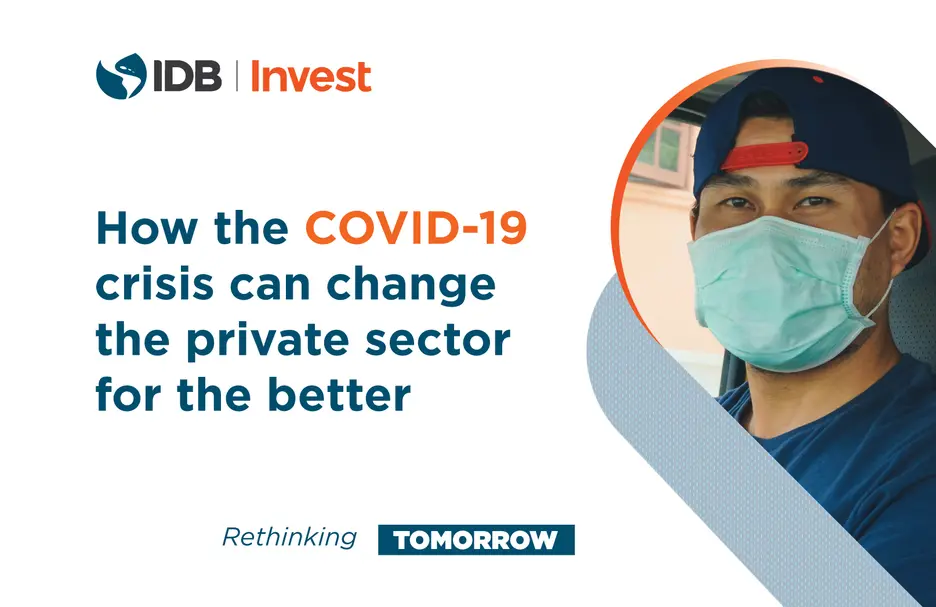How the COVID-19 Crisis Can Change the Private Sector for the Better

In Latin America and the Caribbean, the worst of the COVID-19 health and economic crises still lie ahead. On March 31st, IDB Group’s President Luis Alberto Moreno predicted the region would experience a deep recession. He cited existing slow growth exacerbated by COVID-19, social distancing orders, consumer spending declines and downturns in the region’s main trading partners, the US and China.
Markets are reacting. Currencies are volatile. Brazil’s and Uruguay’s currencies depreciated more than 15%. Oil, copper, soybeans and sugar price drops are further disrupting supply chains and forcing borrowers and lenders to make difficult decisions.
Sovereign spreads in the region have surged. In March, the EMBI spread, an indicator of perceived country risk in the markets, increased 80% in Brazil, Chile, Paraguay and Uruguay. On average, regional stock markets dropped 25% in synchrony with the S&P’s 20% decrease.
While these indicators paint a grim picture, our region may still have the benefit of time. Asia, Europe and the United States are a few weeks ahead of us, providing insights into private sector decision-making and highlighting how interconnected, flexible and agile we can be when pushed to our limits.
In the short-term, supporting people’s health comes first. In addition to decisions to telework, banks and multilaterals are adapting financial instruments to mobilize virus testing, medical equipment, vaccines and treatment for those impacted.
Financial solutions include shortened tenors, standstills on principal to sustain cash flows, interest rate swaps and revised amortization schedules. These can support small businesses to shift production to health-critical sectors and sustain jobs. IDB Lab, for example, created an interactive map to surface the work of entrepreneurs trying to alleviate the health crisis.
Outside healthcare, priorities include financing jobs and income. Short-term credit lines can boost liquidity and working capital for micro, small and medium-sized enterprises (MSMEs), which are under growing pressure. As the financial sector prepares for portfolio deterioration and country downgrades, we must act quickly to restructure loans to mitigate MSME bankruptcy. Trade and supply chain finance may cushion the shock to small importers, exporters and manufacturers.
However, crisis management is about more than reacting to negative events. Crisis management is also about planning ahead. When the private sector does open back up, can it work even better than before?
Take the digital economy. Going digital requires not only flexibility logistically but also intellectually. Investing in digital infrastructure and internet-enabled services presents an opportunity to deploy exponential technologies in everyday activities. Think food delivery, telework, distance learning, entertainment and especially telemedicine.
Digital infrastructure also supports financial technology firms (fintechs) to meet the high levels of demand for short-term loans. Fintechs in the region have a reputation of inclusivity and growth, tripling their business each year by using smartphone data to make credit decisions. Fintechs could provide MSME loans to the region where 47% of employment is informal and only 1 in 2 citizens have a bank account.
Related to fintech, what if the region used this moment to rethink finance? Blackrock CEO Larry Fink headlined, “climate risk is investment risk,” and this could be our moment to re-price and incentivize investments that contribute to climate resiliency.
COVID-19 is changing our social and financial landscape every day. Many never imagined airlines bankrupt, runs on banks, oil prices so low or grocery delivery companies unable to support demand. This rapidly changing business environment could be our moment to rethink industry.
From tourism to agribusiness to manufacturing, real economy sectors can gain by harnessing innovation. Energy and resource efficiency spares both pocket and planet, climate-smart agriculture protects yields and closed-loop production conserves both financial and natural capital. The WEF reminds us that renewable energy investment now would have the dual-upside of economic stimulus and clean energy acceleration. Industry that is more inclusive to excluded populations – protecting and promoting them as borrowers, customers and employees – can further make a lasting difference.
Some may ask, is a health crisis the right moment to raise such aspirational goals? As we are distracted by the crisis, businesses are creeping into unsustainable ways. The plastic industry is trying to unwind bans on plastic bags, while other companies face complaints of compromising worker safety.
In crises, decision-making must become leaner and more agile. This crisis, unlike previous ones, may take longer to recover, adding urgency that the swift decisions taken today will impact our economy and world over more time. We see this as more a marathon than a sprint.
At IDB Invest, we can double-down, working harder to provide immediate financial support to companies who need it most. We can cushion the shock through trade and supply chain finance, provide flexibility to our existing clients and make smarter, more sustainable decisions for the road ahead.
This is one of the few moments in history when no individual or institution can stand on the sidelines. Let’s use this collective motion to push ourselves to innovate. Now more than ever the private sector needs responsible, sustainable solutions.■
LIKE WHAT YOU JUST READ?
Subscribe to our mailing list to stay informed on the latest IDB Invest news, blog posts, upcoming events, and to learn more about specific areas of interest.
Subscribe



